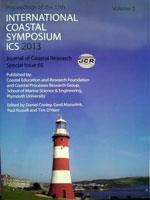Lima, N. G.B, Galvani, E., Falcão, R. M. and Cunha-Lignon, M., 2013. Air temperature and canopy cover of impacted and conserved mangrove ecosystems: a study of a subtropical estuary in Brazil. In: Conley, D.C., Masselink, G., Russell, P.E. and O'Hare, T.J. (eds.)
The aim of this study was to analyze and compare the variation of air temperature between impacted and conserved mangrove areas by monitoring the microclimate and canopy cover of mangrove forests in the southern coast of São Paulo State, Brazil. Data were collected from September 2011 to August 2012 using meteorological towers installed below the canopy at a height of 2 m. Hemispherical photographs were processed to acquire the canopy opening and Leaf Area Index, which quantifies the area with leaves, trunks and branches. The mangrove vegetation structure was characterized in permanent plots located in conserved and impacted areas. All plants were identified and described. Evaluations of the temperature data using Pearson linear correlation, T Paired and Wilcoxon tests with a significance level of 5% indicated a 94% correlation with r = 0.973. The vegetation was dominated by Rhizophora mangle (red mangrove) in both areas. The conserved mangrove forest presented a continuous recruitment of red mangrove seedlings and saplings, whereas the impacted mangrove forest was characterized by mangrove associate species and aquatic macrophytes, indicating environmental alteration. The absolute maximum temperatures recorded in the impacted and conserved mangrove forests were 36.1°C and 35.6°C, respectively. Moreover, the minimum recorded temperatures in the impacted and conserved mangroves were 8.6°C and 9.7°C, respectively. These results indicate that the temperature amplitudes are lower in the conserved mangrove (25.9°C) than in the impacted mangrove (27.5°C) and that the conservation status of the mangrove canopy contributes to the temperature variation in this environment.





